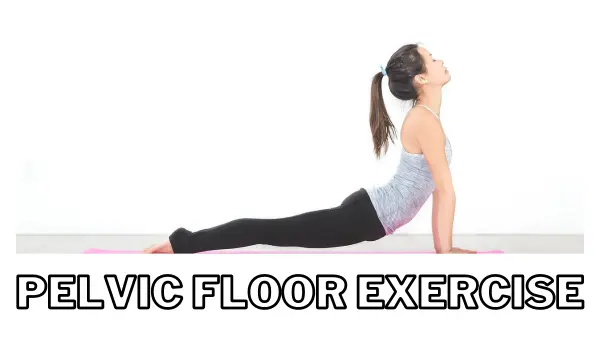Introduction:
Explore how postpartum pelvic floor exercises can be good for restoring core strength after a c-section. Unlock the fast recovery with the best postpartum pelvic floor exercises or post-c-section workout here!
As widely acknowledged, the recuperative process following surgical intervention or the manifestation of a pathological condition necessitates a specific duration. Certain specialized activities can facilitate your recuperation following a cesarean section surgical procedure. Engaging in exercises involving the pelvic floor and abdominal part also provides beneficial effects.
It is commonly recommended that following the 5–9-week postnatal examination conducted by a healthcare provider, one may gradually augment their physical activity levels under the guidance and approval of their attending physician.
The postoperative recovery period for this cesarean section procedure necessitates an extended duration to facilitate optimal wound healing and mitigate anticipated complications. Gradual restoration of strength will facilitate a smooth transition to engaging in beloved activities.
It has been noted that over the past decade (2011-2021), there has been a consistent decline in the annual proportion of births conducted through the method of cesarean delivery within Italy. 2011, the caesarian section technique was employed in nearly 38 per cent of parturitions. However, as the temporal progression unfolded, the proportion of deliveries conducted via the surgical procedure declined, reaching 32.6 per cent in 2021.
Additionally, it is noteworthy that approximately one-third of neonates in the United States are delivered through the surgical procedure known as c-section (C-section). In 2020, the mean expenditure per parturition through the c-section in California’s San Francisco-Oakland-Hayward metropolitan area amounted to approximately 36,433 United States dollars. In contrast, the average cost per childbirth in Midland, Texas, was nearly 8,051 United States dollars. This statistical representation depicts the mean cost per parturition through the c-section procedure within chosen metropolitan regions in the United States (Juliette Gagliardi, 2023).
The exclusive provider of obstetric care, the midwife, shall impart pertinent knowledge to patients within the medical facility regarding postoperative physical activities that facilitate recuperation after a cesarean section procedure. The attending midwife will advocate for early ambulation once the patient achieves post-bedrest mobility.
In this discourse, we shall delve into the potential ramifications of surgical delivery on the core region, which may ultimately lead to the divarication of the recti. Additionally, we shall elucidate postpartum core exercises, physical therapy, postpartum core exercises, abdominal coming, postpartum belly workout, and some important exercises that would aid in recovery and help you do your house jobs easily.
Describe some postpartum pelvic floor exercises or ab workouts:
Post-C-Section Workout: Certified medical professionals prescribe these exercises according to the patient’s medical condition. Below, we will discuss several post-section exercises that can aid in the healing process and facilitate the restoration of strength.
Deep Breathing Exercise:
- Direct your attention towards diaphragmatic breathing to facilitate optimal lung expansion and assist in recuperation.
- After undergoing a cesarean section, it is recommended that the patient engage in deep breathing exercises to promote relaxation and enhance oxygenation.
- The diaphragm undergoes vertical movement within the respiratory mechanism.
- This exercise is called the diaphragmatic breathing exercise, which specifically engages the transverse abdominis muscle.

Walking:
- The primary and initial activity that a healthcare professional would advise the mother to engage in following a cesarean section surgery is to commence with brief ambulatory exercises.
- Progressively increase the period and intensity of the activity.
- Engaging in regular walking exercises can effectively enhance circulatory function, facilitate the healing process, and elevate energy levels.
Pelvic floor exercises:
For the postpartum pelvic floor exercises, Kegel is recommended to assist women to regain their pre-pregnancy muscular power after giving birth. These muscles are prone to weakening because of the physiological changes that occur during pregnancy and childbirth (Natasha Freutel, 2018).
- Begin with mild contractions and gradually escalate the intensity.
- When engaging the pelvic musculature, one may experience a sensation akin to urinary retention, while its relaxation may elicit a feeling of urinary release.
- Perform this exercise with 10-14 repetitions within 3 minutes for optimal outcomes.
- This exercise is an excellent way to strengthen your pelvic floor muscles.
- Please perform this exercise with 10-14 repetitions within 3 minutes for optimal outcomes.
- It is advised to engage in physical activity as your medical practitioner recommends constantly.

Transverse Abdominis Activation:
- Doing gentle exercises following any surgical procedure is recommended.
- During transverse abdominis activation, it is imperative to actively involve the deep core muscles by initiating the movement of the belly button towards the spine while maintaining a neutral spine position.
- This postpartum pelvic floor exercise recommends assuming a supine position and gently placing a fabric material on your foot.
- Inhale profoundly and flex your lower extremity towards your torso while ensuring proper body alignment.
- Exhale and extend your lower extremities to return to the initial posture.
- In a postpartum belly workout, you can engage in activity for 8-14 repetitions within 2 minutes daily.

Basic abdominal contractions:
- In postpartum belly workout, our primary objective is to enhance the strength of our core musculature.
- The recommended position for this activity involves assuming a supine position with the knees flexed.
- You must position your hands on your abdominal region and proceed to engage your abdominal muscles in a controlled manner. Exhale while initiating the contraction and inhale while gradually releasing the contraction. This postpartum core exercise would greatly help in core strengthening.
Bridge Exercise:
- Assume a supine position with your lower body flexed at the knees and your feet resting firmly on the ground.
- Elevate your pelvis from the surface, activating your gluteal muscles and engaging your core musculature.
- Maintain the current position briefly, followed by a controlled descent.
Lower Body Exercises:
Engage in low-impact leg exercises such as ankle pumps, leg lifts, and heel slides to enhance blood circulation and mitigate the risk of developing blood clots It is regarded as the best among other postpartum pelvic floor exercises.
Upper Body Exercises:
Engage in low-impact upper extremity exercises such as scapular retraction, circumduction of the arms, and incline wall push-ups to enhance blood flow and preserve upper-body muscular endurance.
Stretching:
Engage in controlled and deliberate movements to enhance flexibility and alleviate muscular tension. Please prioritize attention to the musculoskeletal regions, including the dorsal region, cervical spine, scapular region, and pelvic girdle.

Postpartum abs workout:
During this discussion, we will cover the proper method of initiating postpartum pelvic floor exercises, walking, and stretching. You must follow the correct techniques to achieve optimal results and avoid potential risks. Therefore, please pay close attention to the instructions and ensure you implement them accurately. Following five to nine weeks, as your healthcare provider recommends, you may gradually incorporate deep core work into your routine (Cassie Shortsleeve, 2023). Here, we list efficient exercises that can be incorporated into your daily routine during your postpartum recovery or at any stage of life for optimal results.
If you have recently received medical clearance, starting with the least demanding option is advisable. It applies to individuals with divarication recti or those who have recently been cleared after a cesarean section. As you advance in the postpartum workout challenge, gradually increasing your workout’s duration and intensity is recommended. You can slowly increase how long and how hard you exercise.
Belly Breathing:
The belly breathing exercise enhances your focus on breathing and engages the deep inner core muscles, promoting their connection, strength, and functionality. Engaging your inner core muscles and maintaining proper breathing techniques can prevent abdominal leakage and back pain and enhance overall strength and stability during activities such as jumping, sneezing, laughing, and daily movements.
Kegel Exercise:
Inhale and relax your pelvic floor, then exhale and lift your pelvic floor. Imagine zipping up your pelvic floor as you exhale. Repeat this exercise one more time. Please ensure proper breathing technique as we transition to the supine position. Begin by carefully transitioning from the side to lying on your back while engaging your abdominal muscles. Bring your heels closer to your body, allowing your fingertips to touch them.
Let us initiate pelvic tilts by exhaling. We will perform a lumbar compression maneuver, where you will elevate your tailbone and take a deep breath into your ribcage. Perform an anterior tilt and exhale while applying pressure to your lumbar region. It will activate the bony hip protrusions, resulting in a sensation of tension. Inhale to relax and exhale again. Inhale deeply, expand your lungs and then release your breath. Inhale and engage, we can incorporate a bridge into this. Let us proceed with the exhalation. Take a deep breath, exhale slowly, and engage your pelvic floor muscles. Prepare to lift your pelvic floor muscles as if you are knitting them together. Lift your hips to form a bridge and then release them back down, fully relaxing at the bottom.
Take a deep breath during this process. Perform the Kegel exercise by exhaling and lifting, then inhaling and releasing. One of my preferred exercises is a modified version of the Pilates exercise called “The Hundred.” For individuals who have recently given birth, it is possible to perform this exercise by engaging in arm pulsing movements. Another variation involves exhaling while raising the legs to a tabletop position and pulsing.
Maintain proper breathing techniques and focus on engaging your core muscles. Perform steady breaths throughout the exercise. Gently lower your legs while exhaling. Place your hands on your lower abdomen near the bony hip protrusion.
Heel Slide Exercise:
We will now proceed with a heel slide exercise. Perform a controlled exhalation while initiating a heel slide outward. Imagine a water gloss on top of your opposite knee and proceed to open your knee to the side without moving your hips or other leg. For more advanced individuals, you may begin with your legs elevated and extended, then open them outwards to the side. Maintain a steady exhalation as you extend and focus on feeling the engagement within your hip protrusions. Your abdominal muscles are actively involved in this exercise, strengthening core muscles.
Pelvic floor muscle exercises:
This exercise is beneficial for strengthening the muscles in the pelvic area. Please extend the arm nearest to me. Lie down on the ground with your palm facing upwards. We will roll onto our side while exhaling and activating our core muscles. To ensure stability, you may bend your bottom leg and then extend your upper leg. You can now perform an oblique crunch by aligning your hips and then exhaling while activating your oblique muscles, bringing your arm and leg closer together.
Modified Plank:
Get ready to strengthen and tone your core muscles with the unique modified plank exercise! This exercise specifically targets your abdominals, obliques, and lower muscles.
Let’s transition into a modified plank position by bringing your forearm in line with your elbow, hip, and knee. Find what works best for your body and take it slow. Listen to your body as you exercise, whether you keep both feet on the ground or lift one. Dip down and return up, ensuring your hips are stacked and lifting through your side body. Engage your core and release it down. Roll over to the other side for better visibility. Place your bottom hand on the ground and prepare for oblique crunches.
For individuals with diastasis recti, performing the easiest exercise variation is recommended. Begin by engaging your core muscles and pressing your knees into the ground. Next, tuck your toes and lift your body slightly off the ground, holding this position for ten seconds. You can step your legs back instead of having a more advanced version. Regardless of the variation, remember to lift and hold for ten seconds, then release and take a deep breath.
It is indeed advisable to avoid performing anchored twists postpartum, particularly if you have diastasis recti. However, engaging your inner core muscles in a gentle twist can have potential benefits. Remember, twisting is not mandatory. Initially, you can find it challenging to discern the varying levels. However, with continued practice, you can gain proficient control over your pelvic floor and perform your postpartum abs workout more effortlessly. These exercises play a crucial role in recovering your core and can also implement certain lifestyle modifications to aid healing.
How can a mother avoid recti divarication after a C-Section?
Diastasis recti, medically referred to as divarication of recti, is a physiological condition characterized by the separation of the abdominal muscles, typically observed during the gestational period or in the postpartum phase. To prevent the occurrence of divarication of recti, the mother should engage in gentle and suitable exercises for her current physical condition.
What is the best technique to treat abdominal coning?
You may have heard of a woman who, following a C-section, became concerned about falling victim to abdominal conning. The reason is that the abdominal and pelvic muscles atrophy during pregnancy. This condition can arise after a woman has had a cesarean section, and when it does, the central part of the abdomen typically protrudes due to increased pressure. This condition is called abdominal conning because the stomach will have a cone shape. Simple activities like heel sliding, modified planks, and pelvic floor movements are all required to treat this issue and bring it under control.
Making time for self-care is crucial for our well-being, and I applaud you if you are doing an outstanding job by prioritizing it.
Discussion:
It has been determined that engaging in postpartum abdominal workouts and pelvic floor exercises can significantly aid a mother in resuming her daily activities by effectively strengthening and reconnecting the pelvic floor and core muscles. By gradually increasing the intensity and complexity of these exercises over time, she can effectively minimize the risk of developing this condition. The mother must prioritize these activities. In addition to incorporating therapeutic exercises into your regimen, it is worth considering the inclusion of certain nourishing food items and soothing smoothies that can significantly contribute to the overall healing process.
References:
Natasha Freutel on October 5, 2018, 5 Exercises to Help with Your C-Section Recovery.
Cassie Shortsleeve., February 1, 2023, Postpartum Pelvic Floor Exercises.
Juliette Gagliardi, Jun 29, 2023, Share of births by caesarean delivery in Italy from 2011 to 2021.
Jennifer Kelly Geddes, July 6, 2021, Having a C-Section (Cesarean Section).



![Energize a mom with the Brewer pregnancy diet plan [2024].](https://healthstreamings.com/wp-content/uploads/2023/11/Brewer-Pregnancy-Diet-1-270x162.png)
